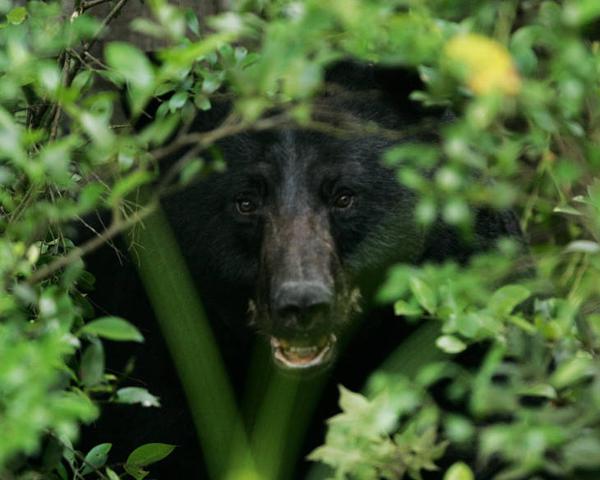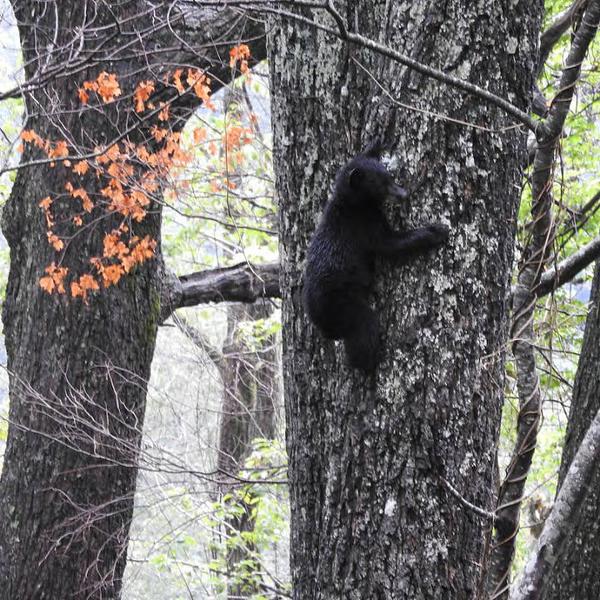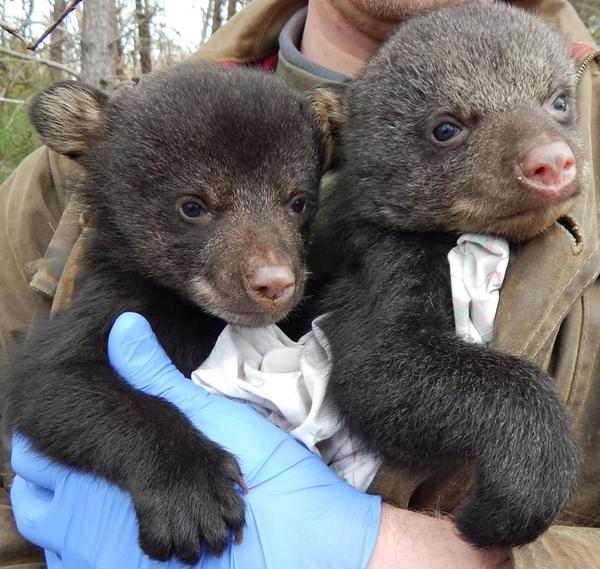Black Bear
The American black bear is the smallest of the three species of bear that occur in the United States, but the largest animal species occurring in North Carolina. This medium-sized bear is usually black with a brown muzzle, lacks a shoulder hump (that is found on the grizzly bear), and may have a white patch or “chest blaze” on the chest. Although black is the predominant color, coat appearance in black bears can also be chocolate or cinnamon brown. Black bears exhibit sexual dimorphism with males being larger than females; adult female black bears generally weigh between 90 and 175 pounds, whereas males weigh between 130 and 660 pounds. The largest documented black bear was a male bear that was harvested from the coastal plain of North Carolina and weighed 880 pounds. Black bears vary considerably in size, depending on the quality of the food available. The species’ life expectancy in the wild is between 10 and 25 years. Black bears have a keen sense of smell and hearing; their vision is less acute, but similar to that of humans and they do see in color. Their night vision is good and they detect movement easily. A bear can smell seven times better than a bloodhound, known for tracking lost people. Its big nose has an area inside (called the nasal mucosa) that is 100 times larger than humans.
Habitat Requirements
Black bears are found in 40 of the 50 U.S. states, and the only species of bear found in North Carolina and the eastern United States. They are present in the southern Appalachian Mountains and the coastal bays and swamps of North Carolina. Black bears are normally found in forested landscapes, but within such areas they are highly adaptable. They live in arid and moist forests, from sea level to over 2,000 meters (6,560 feet). The highest quality habitat for black bears contains a variety of forest stand ages, including mature forests dominated by hard mast-producing hardwoods and young forest with abundant soft mast and dense cover. Bears typically require extensive, rugged country with dense understory, swamps, bays, or rock outcrops, and room to travel widely. Bears occasionally will cause damage in livestock operations, apple orchards, cornfields, or by feeding on the inner bark of some desired tree species.
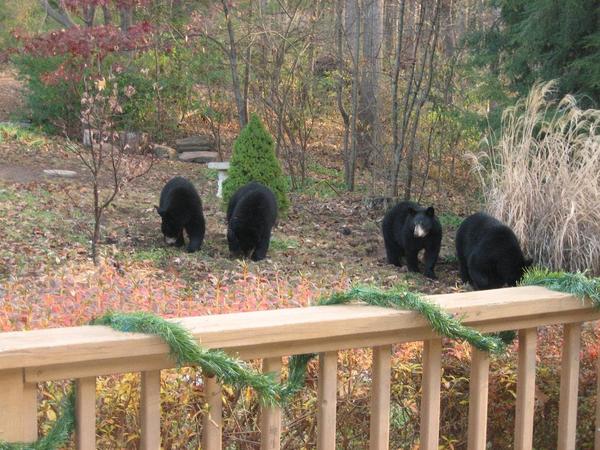
Family group of three male yearlings and their mother black bear.
Nicholas Gould. Wildlife biologist CC BY-NC 4.0
Food
Although technically considered carnivores, black bears are omnivorous, meaning they will eat what is available. The bulk of their diet is hard and soft mast, insects and insect larvae, animals (including fish, retiles, and small mammals), honey, and succulent plants. Black bears can also be efficient predators of deer fawns and elk calves. The amount and types of food eaten by bears varies according to seasonal activities and food availability. Black bears will also readily take advantage of food sources found in urban environments.
|
Common black bear foods |
|
|
Pre-denning (August - November) |
|
|
Acorns |
Blackgum fruits |
|
Holly fruits |
Black cherry fruits |
|
Dogwood fruits |
Beech nuts |
|
Persimmon fruits |
Insects |
|
Mice and voles |
Pokeberry fruits |
|
Denning* (Late October - March) |
|
|
Acorns |
Gallberry fruits |
|
Corn and other residual grain |
Greenbrier |
|
Post-denning (March - May) |
|
|
Arrow arum |
Greenbrier |
|
Grasses |
Pokeberry |
|
Squaw root |
Tree cambium |
|
Insects |
Mice and voles |
|
Breeding (June - July) |
|
|
Blackberry fruits |
Huckleberry fruits |
|
Blueberry fruits |
Serviceberry fruits |
|
Viburnum fruits |
Insects |
|
Mice and voles |
Deer fawns |
Cover
Near areas of human activity, black bears often bed down in dense understory vegetation (e.g., mountain laurel, rhododendron, etc.) in daytime and do much of their moving at sunrise and sunset or during the nighttime. Bears sometimes use trees for resting places. Bears go into winter dormancy anywhere from early October through early April in the southern Appalachians. Bears den in large tree cavities or underneath downed or hollow logs, rocky outcroppings, and dense thicket/understory.
Escape Cover
- Rugged terrain such as steep, rocky, mountainous slopes
- Mountainsides laced with laurel, rhododendron, grapes, and greenbrier thickets
- Extensive areas with minimal human disturbance
- Carolina bays and pocosins in eastern North Carolina
The most important element of escape cover is protection from people, dogs, and vehicles.
Water
Bears require regular access to water sources. Two or more sources of permanent open water per square mile of range should be available.
Home Range
Typical black bear densities range from one bear per square mile to one bear per seven square miles. The home range of bears in the Southeast ranges from 6 to 19 square miles for females to 18 to 160 square miles for males. Home ranges must include den sites, food, water and cover for adults and young. Home ranges and bear densities may vary considerably depending on available food sources. Mast shortages may result in considerable wanderings and/or expansion of home range size, so other important fall and winter foods should be maintained at high levels to deter movement into areas where bears are more vulnerable or may become involved in negative human-bear interactions.
Living With Bears
BearWise Basics:
1. Never feed or approach bears.
2. Secure food, garbage, and recycling.
3. Remove bird feeders when bears are active.
4. Never leave pet food outdoors.
5. Clean and store grills.
6. Alert neighbors to bear activity.
For additional information, please visit BearWise.
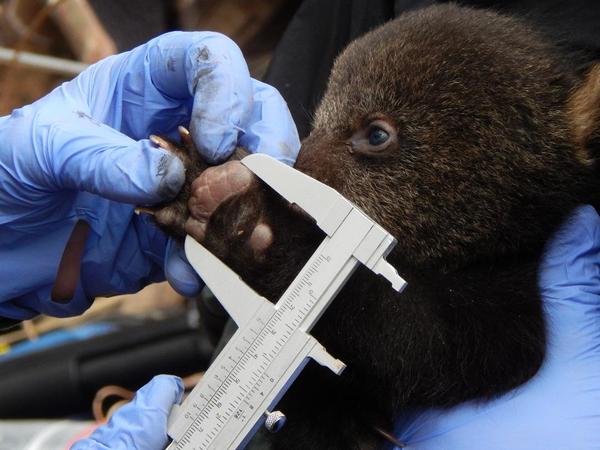
Researchers taking measurements on a black bear cub.
Nicholas Gould. Wildlife biologist CC BY-NC 4.0
Black Bear Management
Tips for Improving Black Bear Habitat
General
- Provide large expanses of mixed aged forest, with predominantly mast-producing hardwood as the dominant tree species
- Protect streamside zones, which provide travel corridors through urban and agricultural landscapes
Rotation
- Manage for long rotations in hardwood types (60 years or more)
- Limit harvesting to 25 acre stands or less
- Retain mature forest along rivers and swamps
Regeneration
- Avoid extensive clearcutting and instead use shelterwood regeneration harvests that retain mast-producing overstory trees that also may provide den sites
- Regenerate at least 10% of total management area in a 10-year period
Intermediate Treatments
- Thin occasionally to encourage crown growth, yet avoid frequent disturbances
- Burn frequently (3 to 7 years) to encourage understory growth and soft mast production
Direct Improvements
- Retain trees with large cavities and large diameter standing dead trees
- Select and retain large diameter trees with potential to develop large cavities
- Limit access and disturbance to management areas
Species That Benefit From Black Bear Management
Numerous game and nongame species benefit from black bear management. Rather than focusing on a single species, habitat management plans should emphasize the communities which include black bears. The following species are just a few that benefit from black bear management:
- Gray squirrel
- Raccoon
- White-tailed deer
- Wood duck
- Great horned owl
- American redstart
- Pileated woodpecker
- Ruffed grouse
Citations Used / Additional Resources
BearWise. All about black bears. Accessed 07-05-2019.
International Association for Bear Research & Management. Bears of the World. Accessed 07-05-2019.
Working With Wildlife
North Carolina State University Extension - Forestry
Working With Wildlife Series
Publication date: July 1, 2019
Reviewed/Revised: May 28, 2024
N.C. Cooperative Extension prohibits discrimination and harassment regardless of age, color, disability, family and marital status, gender identity, national origin, political beliefs, race, religion, sex (including pregnancy), sexual orientation and veteran status.
N.C. Cooperative Extension prohibits discrimination and harassment regardless of age, color, disability, family and marital status, gender identity, national origin, political beliefs, race, religion, sex (including pregnancy), sexual orientation and veteran status.

